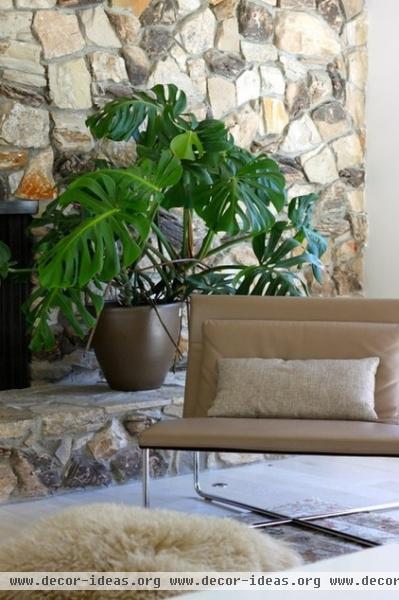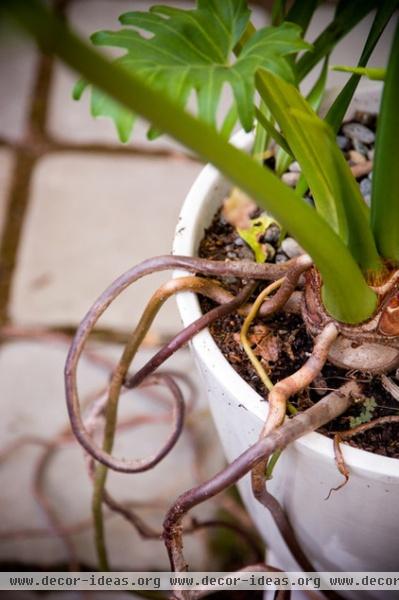Conjure a Jungle in a Pot
http://decor-ideas.org 09/25/2013 00:30 Decor Ideas
For a tropical splash that adds drama to any space, split-leaf philodendron and Lacy Tree philodendron are two great houseplants with similar low-maintenance needs. They both have a look that verges on overgrown jungle, depending on the variety and how much you decide to control its growth.
While split-leaf grows quickly and requires more space if not controlled, Lacy Tree varieties differ greatly in size, allowing you to enjoy a potted philodendron just about anywhere in your house.
Caution: Philodendron is toxic if ingested by pets or young children.

Split-leaf philodendron (Monstera deliciosa) is a climber, as are most philodendron varieties. It's also known as Swiss Cheese plant, due to holes on its large, glossy green leaves alongside deeply curved splits. This impressive plant is well suited to a large hall or a spacious room, in a spot with plenty of good light.
Split-leaf can grow as tall as 10 feet, so it generally needs to be staked or given a pole on which to climb.

Be careful when choosing the location for your split-leaf; once it becomes habituated, it does not like to be moved and may react to being moved by dropping its leaves. And make sure it has good air circulation to avoid infestation.

Split-leafs have been used as houseplants for centuries; they were an especially popular design element in the 1950s.

Lacy Tree philodendron (Philodendron bipinnatifidum, or Philodendron selloum) is not a climber; it grows as a large semiwoody shrub with enormous glossy leaves and a single erect unbranched stem that tends to fall over and sprawl when the plant gets large. You'll want to give a Lacy Tree plenty of room: It can eventually sprawl to become twice as wide as it is tall.

A small Lacy Tree fits nicely on a countertop, where it can get the indirect light it loves.

The glossy leaves of a Lacy Tree become more deeply cut as they grow, hence the name.


To keep your plant healthy and attractive, gently wipe dust from the leaves with a damp cloth.
The robust stem of the Lacy Tree bears stout aerial rootlets.

How to care for your philodendron:
Temperature: Average to warm, about 60 to 80 degrees Fahrenheit (16 to 27 degrees Celsius). Split-leaf philodendron thrives at temperatures above 80 degrees and will very likely not grow at temperatures lower than 65 degrees; Lacy Tree is hardier and more tolerant of lower temperatures.
Light: Moderate to bright light. No direct sun, which can cause brown scorch marks on the leaves. Choose an area with bright indirect or filtered sunlight, such as a south-facing window or a room with light-colored walls that reflect light. Keep plants 2 to 5 feet away from windows to avoid direct light, which causes leaf burn, as well as cooler temperatures or drafts in the winter. Yellowing of the lower leaves may be a sign that your plant needs more light.
Water: Moderate. Water once every seven to 10 days; keep the soil moist from spring through fall and allow its surface to dry out between waterings in winter. Overwatering can cause yellow leaves.
Soil: Use a peat moss–based potting mix or premium potting soil with one-fourth added perlite for good drainage.
Feeding: Feed monthly spring through fall with a balanced liquid fertilizer diluted by half; cut the feeding schedule by half during the winter months or stop feeding entirely if your plant is living below 68 degrees Fahrenheit. If new growth lacks the characteristic perforation, the plant may need more frequent fertilization; burnt foliage tips suggest overfertilizing.
Humidity: Philodendrons are tolerant of dry air but like humidity. Mist the foliage occasionally. Lacy Tree has thinner leaves than most species in the genus and therefore needs more humidity. Mist regularly if the air is very dry or consider using a room humidifier near the plants in the winter.
Origin: The split-leaf is native to tropical rain forests from southern Mexico to Colombia. It has been introduced to many tropical areas and has become a mildly invasive species in Hawaii. Lacy Tree is native to the rain forests of Paraguay and southeastern Brazil.
Repotting tips: Repot every two years, or sooner if the plant becomes root bound and has outgrown its pot. Choose a new pot that is 1 inch larger in diameter than the current pot and has drainage holes in the bottom.
Mix equal parts peat moss, perlite and potting soil, and fill the container one-quarter full with the mixture. Remove the plant from the old pot and center the plant's root ball in the new pot. Fill the area around the perimeter with the extra soil mix and tamp it down firmly around the roots. Water immediately after replanting.
More guides: Find the right houseplant for you
Related Articles Recommended












